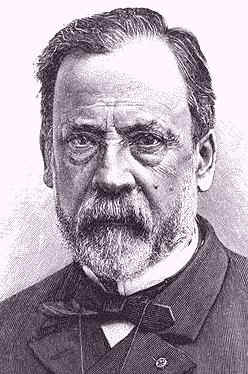Louis Pasteur
Louis Pasteur was born in 1822 to a family of modest means.
Working for his doctorate in the
 laboratory of Antoine Balard, Pasteur at 26, was able to use the techniques
of crystallography to explain the existence of stereoisomers of molecules in natural
substances. Later Pasteur married and move to the town of Lille to become Dean and
Professor of chemistry at the Faculty of Science. While in Lille, Louie Pasteur began a
twenty year study of the process of fermentation. Beginning his research using the methods
of a chemist, Pasteur soon realized he needed to develop new procedures and new ways of
studying chemical reactions. Actually, he developed methodologies that would evolve into
the discipline known as bacteriology, the study of bacteria. The age-old theological
debate known as spontaneous generation was finally dispelled by Pasteur by proving
that putrefaction and decay were caused by chemical reactions produced by microorganisms.
Pasteur was able to demonstrate that the chemical conversion of sugars to alcohols or
acids was performed by microorganisms.
laboratory of Antoine Balard, Pasteur at 26, was able to use the techniques
of crystallography to explain the existence of stereoisomers of molecules in natural
substances. Later Pasteur married and move to the town of Lille to become Dean and
Professor of chemistry at the Faculty of Science. While in Lille, Louie Pasteur began a
twenty year study of the process of fermentation. Beginning his research using the methods
of a chemist, Pasteur soon realized he needed to develop new procedures and new ways of
studying chemical reactions. Actually, he developed methodologies that would evolve into
the discipline known as bacteriology, the study of bacteria. The age-old theological
debate known as spontaneous generation was finally dispelled by Pasteur by proving
that putrefaction and decay were caused by chemical reactions produced by microorganisms.
Pasteur was able to demonstrate that the chemical conversion of sugars to alcohols or
acids was performed by microorganisms.
Pasteur was to hold positions in several French universities
throughout his life. His research with microorganisms led to significant contributions to
the wine and silkworm industry. Louie Pasteur developed the technique of pasteurization to
kill disease-causing microorganisms from liquids. He identified three different
microorganisms that caused different diseases in the silkworm. His association of specific
organisms with particular diseases, even though in silkworms rather than in humans, was an
important first step in proving the germ theory of disease.
Later in life, Pasteur developed the process of attenuation. He
was able to transfer and re-grow bacteria numerous times and in doing so, recognized that
many times the bacteria became weakened. Pasteur soon realized that weakened strains of
microorganisms could be used as vaccines. He is best known for his successful rabies
vaccine.
In 1894 Pasteur became the director of the Pasteur Institute,
which was built for him in Paris. Until his death in 1895, he guided the training and work
of other scientists at the Institute. He developed the methodology of
maintenance,
transfer, growth, and identification of microorganisms in a time that did not believe
living organisms smaller than the eye could see existed. It is through his research and
training of others that Louie Pasteur became known as the "Father of
Microbiology".
Life and
Times of Louis Pasteur
Louis Pasteur
 laboratory of Antoine Balard, Pasteur at 26, was able to use the techniques
of crystallography to explain the existence of stereoisomers of molecules in natural
substances. Later Pasteur married and move to the town of Lille to become Dean and
Professor of chemistry at the Faculty of Science. While in Lille, Louie Pasteur began a
twenty year study of the process of fermentation. Beginning his research using the methods
of a chemist, Pasteur soon realized he needed to develop new procedures and new ways of
studying chemical reactions. Actually, he developed methodologies that would evolve into
the discipline known as bacteriology, the study of bacteria. The age-old theological
debate known as spontaneous generation was finally dispelled by Pasteur by proving
that putrefaction and decay were caused by chemical reactions produced by microorganisms.
Pasteur was able to demonstrate that the chemical conversion of sugars to alcohols or
acids was performed by microorganisms.
laboratory of Antoine Balard, Pasteur at 26, was able to use the techniques
of crystallography to explain the existence of stereoisomers of molecules in natural
substances. Later Pasteur married and move to the town of Lille to become Dean and
Professor of chemistry at the Faculty of Science. While in Lille, Louie Pasteur began a
twenty year study of the process of fermentation. Beginning his research using the methods
of a chemist, Pasteur soon realized he needed to develop new procedures and new ways of
studying chemical reactions. Actually, he developed methodologies that would evolve into
the discipline known as bacteriology, the study of bacteria. The age-old theological
debate known as spontaneous generation was finally dispelled by Pasteur by proving
that putrefaction and decay were caused by chemical reactions produced by microorganisms.
Pasteur was able to demonstrate that the chemical conversion of sugars to alcohols or
acids was performed by microorganisms.